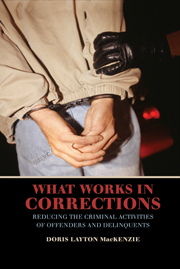Book contents
- Frontmatter
- Contents
- Acknowledgments
- PART ONE STRATEGIES FOR REDUCING CRIME
- PART TWO THE EFFECTIVENESS OF REHABILITATION PROGRAMS
- PART THREE TARGETING SPECIFIC TYPES OF OFFENDERS
- PART FOUR MANAGEMENT AND TREATMENT OF SUBSTANCE ABUSERS
- 11 Drug Courts: A Strategy for Managing Drug-Involved Offenders
- 12 Drug Treatment Programs for Offenders
- PART FIVE CONTROL, DISCIPLINE, AND PUNISHMENT
- PART SIX CONCLUSIONS
- References
- Index
- CAMBRIDGE STUDIES IN CRIMINOLOGY
12 - Drug Treatment Programs for Offenders
Published online by Cambridge University Press: 27 July 2009
- Frontmatter
- Contents
- Acknowledgments
- PART ONE STRATEGIES FOR REDUCING CRIME
- PART TWO THE EFFECTIVENESS OF REHABILITATION PROGRAMS
- PART THREE TARGETING SPECIFIC TYPES OF OFFENDERS
- PART FOUR MANAGEMENT AND TREATMENT OF SUBSTANCE ABUSERS
- 11 Drug Courts: A Strategy for Managing Drug-Involved Offenders
- 12 Drug Treatment Programs for Offenders
- PART FIVE CONTROL, DISCIPLINE, AND PUNISHMENT
- PART SIX CONCLUSIONS
- References
- Index
- CAMBRIDGE STUDIES IN CRIMINOLOGY
Summary
INTRODUCTION
The United States declared a “war on drugs” in the early 1980s. This “war” was based on a control philosophy of corrections and focused on the use of deterrence and incapacitation to try to reduce drug use and drug-related crimes. Severe penalties for drug-involved offenders were expected to reduce drug use and its related criminal activities. These policies resulted in a tremendous increase in the number of drug-involved offenders in prisons. For example, according to a 1997 survey of incarcerated offenders, 57 percent of the state inmates and 45 percent of federal inmates reported drug use in the month prior to their offense. Surveys of state inmates in Texas and Ohio reported that 56 percent and 51 percent, respectively, were diagnosed to need drug treatment. Many of these offenders were convicted of drug crimes (Lo & Stephens, 2000; Peters, Greenbaum, Edens, Carter, & Ortiz, 1998).
During the 1990s, it became obvious that the war on drugs was not having the desired effect. Federal, state, and local law enforcement agencies had responded to the drug crisis by targeting drug suppliers and users. Severe penalties for such drug-involved offenders were expected to keep the offenders in prison for longer periods of time and deter others from dealing or using drugs. These tactics proved to be ineffective in reducing the supply of drugs in most communities. Drug-involved offenders continued to be a problem for criminal justice systems.
- Type
- Chapter
- Information
- What Works in CorrectionsReducing the Criminal Activities of Offenders and Deliquents, pp. 241 - 274Publisher: Cambridge University PressPrint publication year: 2006

